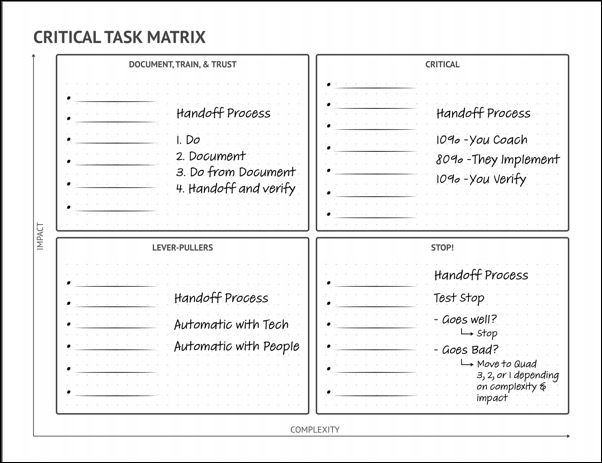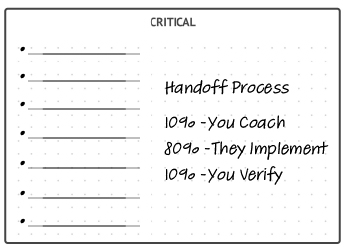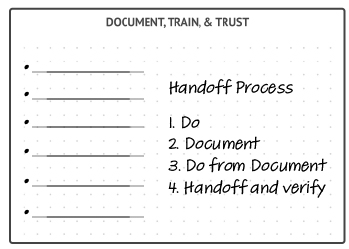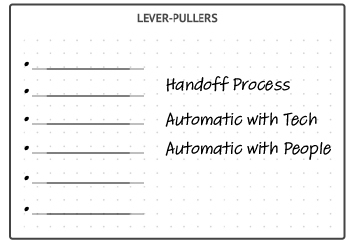
Do you know any “control freaks?”
Maybe it was a teacher or a coach. Or maybe it was an old boss, or even a parent. But whatever form they took, you know the type…
They’re the ones always hovering over your shoulder and “suggesting” that maybe you should just change this one tiny-tiny little detail (i.e. the whole process) before you finish.
We roll our eyes…we grumble…but if the control-freak is an authority-figure, we bite our tongue and get back to work doing it “their way.”
But we don’t like it.
Well, I’ve got some unfortunate news for you…
If you’re a founder or first-time manager, that “control freak” I described, above, just might be you now.
But don’t worry, at one point in time I was that manager, too…and honestly, I’m still fighting hard to not be that guy.
When I first started leading, I struggled to let go and delegate tasks. I found myself thinking, “If I don’t do it, it won’t get done.”
And that idea honestly felt like the truth. After all, building a business from the ground up required years of me wearing a ton of hats and well… doing seemingly everything. It’s the necessary evil of being an entrepreneur.
But once the business started growing, and we had put together a team of amazing employees, I learned really quick that my desire for control was getting in the way of my business’s success.
You see, contrary to popular belief, the best leaders are NOT the busiest leaders. In fact, being a busy leader is a sign that you have room to grow. Fortunately, that’s what this post will help you do, so let’s dig in…
What Happens When You Can’t Let Go:
Being the only one with all the critical knowledge can result in a pretty unproductive environment.
Here’s why:
#1. Lack of Trust
Leaders who don’t trust their staff oftentimes catch themselves saying the same things I was thinking before: “Nothing happens unless I do it.” or “If I don’t do it, it won’t get done.” This mindset reflects poorly on you and your employees. If they don’t feel trusted by you, then they won’t trust themselves.
That trust is so important when you start asking employees to take on more important tasks or bring up new ideas and initiatives. People want to do good work, they just need a safe, encouraging environment to do so.
#2. Shoulder Taps
How many times a day do you hear, “Got a minute?” or “Hey, can I ask you something really quick?” And of those times, how often is the question that follows something that only you can answer?
Questions like this are why it is incredibly important to have a process for duplicating the unique knowledge you have. If you’re the only one with all the answers, you’ll never get anything done because you’ll be too busy answering everyone else’s questions.
Remember: You are the leader, not the one-man search engine.
#3. You’re Stuck
The biggest downfall of being responsible for everything is getting stuck. There is barely enough time in the day to complete all of our most crucial tasks.
Best-case scenario, you miss at least one task during the day or produce less than quality work. And if you’re so busy focusing on what is (or was) critical in your business now, you can’t focus on what WILL be critical for the future.
This is why, as leaders, it is so important that we learn how to delegate tasks to our staff and create an environment where they feel they can do their best work.
Why Delegate?
By delegating tasks in your business, you’ll gain a whole new world of opportunity for growth. The tool I’m going to walk you through will help you…
- Build up a team of experts – This process will help you assign a team of people to do the critical tasks you used to do last week, last month, etc. Having these experts hyper-focused on specific tasks means they’ll be able to optimize and create even better processes.
- Get to focus on the critical – With your team of experts focused on the needs of your business right now, you’ll be able to really focus on what your business needs long-term. This means more time for you to hone in on what it takes to grow and scale your business (like, say, completing the Scalable Operating System.)
- Lose a lot of your limits – By freeing up your time, and building a team of experts, your capacity to grow and scale your business is unlimited! Tis power in the team—how many hours you collectively have available, how much knowledge each of you can acquire on a subject, etc. This means you’re not only stretching your own limits—your teams limits will stretch too.
So how do you go about delegating critical tasks? Don’t worry, I’ve got you covered.
Read on to learn about our infallible (yet simple) Critical Task Matrix worksheet that will put you and your employees on the right track for success.
The Critical Task Matrix

The Critical Task Matrix is a process to help get your business out of your brain and increase the capacity of the total organization.
Download the worksheet (also found in the resources section) and follow these steps to begin filling it out.
Step 1: Build your Master List of Tasks
First things first, build a list of everything you do in your business on a given day.
And I do mean everything.
Even the small stuff like ordering snacks, signing paychecks, and booking flights.
Next, expand that list to the past week.
What did you do over the past 7 business days? Make sure you’re taking note of what you actually did, not what you would have completed in an ideal world.
Next, think back over the past month. What are the tasks that you did (or didn’t) get done? Think about your never-ending to-do list. What items have been sitting there unmoving over the past month?
It can be helpful to do this exercise with a fellow leader or someone in a role similar to yours. By sharing each other’s’ lists, you may discover some tasks you forgot to list.
Now that you have a physical list all of these tasks on a piece of paper, you can begin to better categorize critical and not so critical tasks.
Step 2: Determine and Delegate Your Critical Tasks with the 10-80-10 Rule

Now that you have a good idea of all the tasks you do in your business, your next step is to start looking for critical tasks. These are the complex tasks that have a large impact on your business. Basically, if you stopped doing these tasks, your business would not exist.
For me, copywriting was the critical task I needed to delegate. It’s complex (anyone who’s ever written copy will agree with me) and has a huge impact on our business.
For you, it may be running sales calls, doing the bookkeeping, or any other number of things.
Once you identify all those tasks, list them in the top right-hand box on your Critical Task Matrix.
While it may feel tempting to want to save all the critical tasks for you, remember, your job is to plan for the future and problem solve, not work on all the day-to-day business tasks (no matter how critical they are).
So, in order to delegate these more critical tasks, you are going to need to do some active coaching.
This is where the 10-80-10 Framework comes in handy. What is the 10-80-10 Framework? Let me explain…
When delegating a critical (high complexity and high impact) task:
- You Spend the First 10% Coaching – Since these tasks are complex, your first job is to teach your team. Focus on explaining the objectives, KPIs, and strategy. What is the overall goal, how is it measured, and what strategy will be used to get there? Identify the right person(s) in your company to take on this goal, and coach them accordingly. Make sure you are passing down all that tribal knowledge inside your brain.
- They Spend the Next 80% Implementing – Also known as “not your job”, implementation is the hardest part for any leader. This is where you sit back, and let your team do the work. Make sure you are around to answer questions and help clarify but resist the urge to jump in and do it for them. The goal is to help them take ownership of the strategy!
- Together, Spend the Final 10% Reviewing – This is all about verification. Did they create something that will achieve the objective? Do you believe it will hit your KPIs? Most importantly, did they implement the strategy that was approved? If yes, then it’s time to launch! At this point, it’s also okay to add your knowledge or experience if you think it will help improve the final result.
One thing to note:
If your team has come up with a different way to approach and complete the task, that’s fine!
It can be difficult to “hand off your baby” and then have someone change the process.However, as long as the result is in line with the strategy, goal, and will hit the KPI’s, there’s nothing wrong with the process changing a bit.
“My way or the highway” thinking usually just stunts growth.
Step 3: Determine and Delegate “DTT” Tasks with the 4-Step Handoff Process

“DTT” Tasks are those that have a big impact but are less complex. They tend to be the most time consuming, but not necessarily the most difficult.
One great example is booking flights and hotels, if you find yourself traveling often for work.
Is it super complex? No. Does it have a high impact on the business? Well, missing an important speaking engagement would probably put a damper on the business, so yes.
We call these “DTT” tasks because they don’t need handholding forever. All you need to do is document, train, and trust (but verify).
Go ahead and write down all your DTT tasks in the top left-hand box in your critical task matrix.
So, how do you hand off these DTT tasks?
- Do: Complete the task as you normally would.
- Document: While completing the task, take note of your process and what your priorities are. Then create a formal SOP document (standard operating procedure) for that task.
- Do from Documentation: Then, have someone else (maybe a virtual assistant or employee) complete the task based on your documentation.
- Handoff and Verify: Once someone else complete the task, verify that it’s done correctly and then hand that task off permanently.
The majority of your tasks will probably fall into this category. When you think about it, you already have processes in place for most of the tasks you do, so write them down, and delegate them!
Step 4: Determine and Delegate Your Lever-Puller Tasks through Automation

Lever-Pullers are the tasks that have low impact and low complexity. These are those irksome, everyday tasks that need to get done, but you often find yourself dreading to complete because they are so boring.
For me, this was ordering snacks for the office. Every few weeks our office snack stash got low, and I found myself online re-ordering snacks from Costco.
Would the office break down into utter chaos if I didn’t replenish the snacks? Probably not. Was ordering snacks a complex process? again, no. But is this task still important to the wellbeing and daily operations of the business? Mine and the rest of my employee’s appetites would argue yes!
Take a second to write down all of your lever-puller tasks in the bottom left-hand box on your Critical Task Matrix.
The great thing about these tasks is that you can automate them with either technology or people. Oftentimes, these automations already exist outside of your organization. In fact, entire subscription services have been erected with the sole purpose of completing these tasks for you.
So, take some time to research, and you will most likely find a software or service company that will fill your snack drawer for you!
And if you can’t seem to find a service, you can also delegate these tasks out to your employees or a freelancer.
These tasks are the easiest to delegate and removing them from your workload really helps create room for other more impactful, long term tasks.
Step 5: Determine What You Should Just Stop Doing

Take a look at the rest of the tasks on your list. Presumably, since you didn’t categorize them already, you might be at a loss for knowing what to do with them.
Well, I want you to think about this: How important and impactful are these tasks? More importantly, what would happen if you just… stopped doing them?
The best way to track the impact of a task is to simply stop doing it.
That’s why the rest of these tasks go into the bottom right-hand box of your Critical Task Matrix—Because you’re going to simply stop doing them.
Now, if you just stop completing some of these tasks (like time consuming, yet unproductive meetings) it might create fear or anxiety for your employees. After all, people tend to just keep doing things habitually because, humans like routines.
As a way combat this fear and pushback, it’s best to try a “test” stop.
This is where you stop completing the task for a set period of time, say 2 maybe 3 weeks. If there is 0 impact from abandoning this task altogether, then it can probably be stopped completely.
If, however, you find that the task actually was impactful, then you’ll want to pick it back up, and recategorize it to one of the other boxes in your Critical Task Matrix.
If it can be automated, do that! If not, then create an SOP and hand it off to another team member. If it needs more handholding to delegate, use the 10-80-10 rule.
Remember This
There are two very different types of leadership: transactional leadership and transformational leadership.
Transactional leadership tells people what to do, rewards them when they get it right, and fires them when they get it wrong. This is essentially micro-management and is not conducive to a productive work environment.
Transformational leaders clarify the objective, tell people how they will be measured toward that objective, and coach them to success. The Critical Task Matrix is the ideal transformational leadership model that will help you coach your team to success.
Your goal should not be to increase or maximize your capacity. Instead, you should be focused on maximizing your organizational capacity.
Productivity is not the goal; freedom is the goal.
You won’t have true freedom until you learn to create value outside of your own efforts and abilities. The best way to do this is to let go and really teach your staff.
So, start filling out your Critical Task Matrix today so you can spend less time doing, and more time leading.
RESOURCES:
Critical Task Matrix Worksheet


